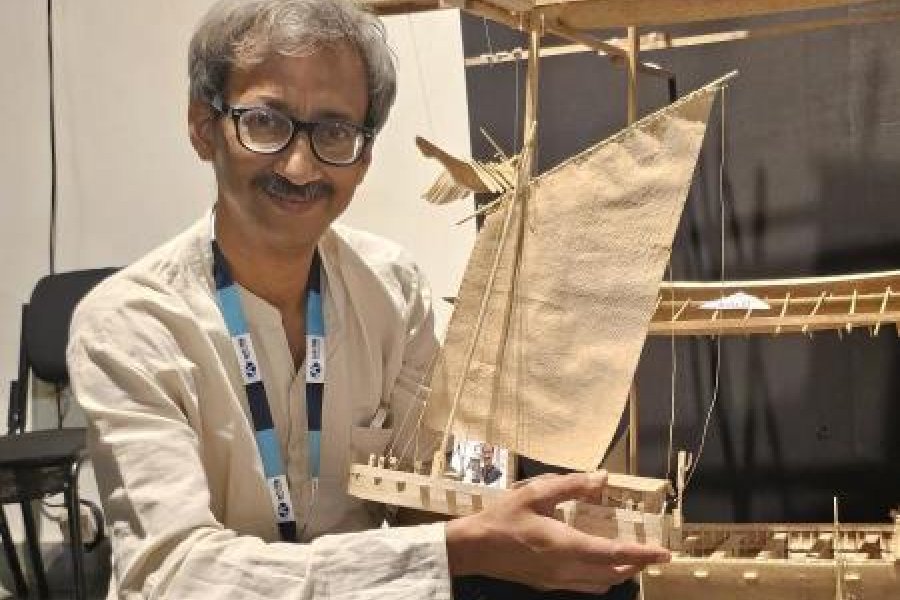A boat made for Bagbazar waters will not sail properly in Budge Budge, so what if the overland distance is less than 30km. Swarup Bhattacharyya’s assertion can be relied upon as the man from Howrah is a boatmaker.
His boats were on view at a recent exhibition titled Art for Life at the CII Suresh Neotia Centre of Excellence for Leadership, behind City Centre, along with the artwork of amateur artists from various professions. The boats ranged in size from seven inches to 30 inches.
Yes, Bhattacharyya makes miniature boats. “Just hold one,” he says, handing one of the larger models to yet another visitor and relishing the surprised reaction to its extreme lightness.
A question inevitably follows: “Is it made of bamboo?” Bhattacharyya explains that small pieces of bamboo cannot be curved. “What I use is balsa wood. It has to be imported from the US,” he says, adding that because of its fine fibre, balsa can be curved and polished with sandpaper, which is what he does to give shape to his mini boats.
His father was a sculptor and young Swarup watched him work closely. “We had handicrafts as a subject in our school-leaving examination. I created a township with models of houses cut out of mountboard, just as I had seen my father make,” he recalls.
After completing an MSc in anthropology, he joined as a research associate at the National Institute of Science, Technology and Development Studies, under the Council for Scientific and Industrial Research. His job was to chronicle boat typology and fishing communities of West Bengal and the Andaman island. “For the next two and half years, I crisscrossed the state, starting with Balagarh in Hooghly, the seat of boat-making, where I stayed over for days to follow the process over three months.”
He also visited Digha, the Sundarbans, Alipurduar, Cooch Behar and Malda, and discovered how the nature of flowing water changes every five to 10 km. “The water of Kansai is not the same as that of Kopai, just as Ichhamati is different from Tista. So there are changes needed in the shapes of boats that ply on each river. Maritime archaeologists have noted this unparalleled variety in the boats of undivided Bengal,” he says.
Bhattacharyya was fascinated to see models of 179 types of boats preserved in a special section at the Bangladesh National Museum in Dhaka. Another chronicle that inspired him was a 1799 book of illustrations by Flemish artist F.B. Solvyns, which had 36 etchings of boats. “I am documenting boats of the modern day,” says he, adding that he has identified 30-35 typological varieties already. The commonest, he says, are the fishing boats, Jele Dingi, seen around the Bagbazar ghats. Then there are fishing boats like Talai. “It is used specifically for hook fishing, in which fishermen release a string with thousands of hooks affixed along the side of the boat over a distance.”
Large boats, 30-40ft in length, carry sticky soil to Kumartuli. Those are made in Baduria, Basirhat. Cargo boats, called mohajoni nouko, carry furniture, clothes, grocery etc from the Posta warehouses in Burrabazar, towards Uluberia in south and Seoraphuli in the north. They are even bigger, 40-50ft long.
Bhattacharyya mentions many more varieties — cargo boats of Malda called Merli; racing boats called Kaile Bachhari; Sultani, which carries heavy cargo like sand; Khoro Kisti, used to carry straw (with kisti presumed to originate from the Arabic term for boat, kasti), the last two being from Geonkhali in East Midnapore... “If East Midnapore is rich in its variety of boats, it is because the sea port of Tamralipta was situated here. Both Sultani and Khoro Kisti seem to be of central Asian origin, not of local make,” he says.
While in Bengal, Bhattacharyya has never dared to set sail himself, the chance to ride the objects of his research came when he went to Denmark in 2001 as a guest research scholar at the Viking Ship Museum, which specialises in experimental archaeology. “The Danish authorities allowed me to sail in the fjords (sea inlet). It was so much easier in the still waters, wearing a life jacket, that I could even hoist and furl the sail. To tackle the natural riverine systems here, one has to know the depth of the water, be able to study clouds, know how to navigate a boat and have adequate muscle power to negotiate current,” he says.
In Denmark, he also saw boat models. The chance to try his hand as part of a project came in 2005 when the Indira Gandhi National Centre for the Arts required him to submit five models. Then, around 2014, a museum in Kankurgachhi commissioned a team led by him to make boat models for a gallery on heritage boats of Bengal.
It was during the lockdown that he got time to hone his craft. Now he makes and puts up the models on sale. At the Salt Lake exhibition, while the small Khoro Kisti sold for Rs 3000, the 30inch Betnai was priced at Rs 90,000. “The small ones take seven days to make while the big ones take over two months,” points out the man who has named his Ramrajatala house Noukoghor.






